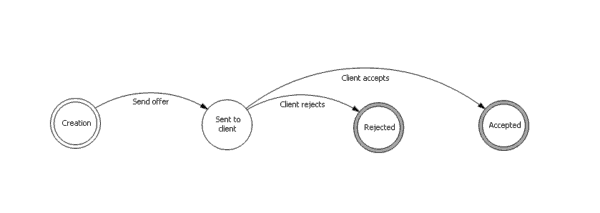
What is a Workflow, BPM, ECM or Process Management Software and how can it help your business
For some time now, the word “Workflow” has been heard in the computer sector as a way of defining the operational aspects of a work activity.
Workflow systems, control and management of work processes. Workflow features are included in a lot of different business software: BPM (Business Process Management), ECM (Enterprise Content Management) everywhere they have the objective of integrating people, computers and processes in order to reduce time and increase control in the execution of any job.

A workflow can be controlled manually or computerized, although the most common is to integrate both methods of process control. Starting from a workflow scheme, tasks and resources are organized through rules that facilitate and simplify the control of a certain process within a company.
The goal: Stardardization
The first objective pursued with a workflow scheme is the maximum standardization of work processes with absolute control of each and every step of each task. The great revolution occurs when you manage to bring the work scheme from a paper schema to a software specifically designed to control business processes.
The workflow control tools allow you to establish the steps of a flow through different types of diagrams. Here is an example of the diagram to control a process of commercial offers in the Document Management and Workflow Software Docuo:
In the diagram we can see the four states (circles) in which an offer can be and the three transitions (arrows) that allow changing states.
Users create commercial offers in the system and move through the workflow “changing the states” of these documents. The system can be configured to perform automatic tasks when the state is changed in a process (for example sending the e-mail to the client with its offer when “sending offer”) or when staying in a state for a long time (for example, notifying the sales team when the offer has been in a state “Sent to the customer” for 10 days).
You can learn more about Docuo workflow features or even try the software for free to better understand these topics:
Different software tools use different diagram types, but the goal of all them is the same: define how do you want a single task to be performed within your team, step by step and convering all possible situations.
Workflow tools and Document Management
Workflow systems have a very important application in document management in particular. The large amount of documentation that is generated within each office, usually follows a certain number of paths or processes that tend to repeat and are capable of being modelled in a workflow scheme and therefore automated in a document management tool with workflow that now In addition can be in the cloud that is accessible from anywhere.
The tools that allow you to implement an optimized workflow are especially demanded at present by big corporations. They facilitate teamwork and there are no doubts when making decisions about the work methodology for a specific process. They allow, above all, decentralized administrative or commercial activities with the consequent benefit for the coordination of large companies.
Before continuing, we should clarify that a work process can be applied to any company or project, logically it depends on the type of organization that can automate more or less parts of the processes. As previously mentioned, the activities that can be easily incorporated in a workflow are administrative, it is very common to repeat the vast majority of the processes to be carried out every month, and that these tasks or processes are exactly the same with small variations within each department or office of the company.

What are the advantages of implementing a Workflow Management Software?
All experts in business productivity recommend the adoption of workflow systems (BPM) for all processes that are susceptible to be automated. This is nothing new, what happens is that now we can implement it with computer applications that also work a step beyond the traditional local network, they work in the cloud.
The advantages cited by all specialists in productivity are among other advantages that are listed below:
- Improvement of the monitoring and control of processes thanks to a standardization in the work methodology.
- Improvement of general productivity and efficiency between departments. It allows savings in the execution times for the vast majority of processes.
- Many of the problems that can arise within a work process are known in advance, therefore, the workflow scheme allows us to anticipate possible failures and anticipate solutions.
- It facilitates the circulation of information within the company itself and therefore the interdepartmental attention times with customers and suppliers are reduced.
- As human resources are finite, capacity is always a challenge in any workflow. Workflow management Software allows to easily detect bottlenecks, overwhelmed and underused profiles.
- In addition of describing a worflow steps, workflow management software also allows to automatize document creation and email sending using templates, this often results in what has been called Office Process Automation: automatize repetitive tasks that can be performed by a computer, rather than an individual.
Proper foresight and order of the tasks to be performed has always been a guarantee of effectiveness in any project. With business globalization, manual control is often impossible, and in any case, a well-planned cloud workflow management application saves a lot of time, money and dislikes to companies.
An adequate integration with the data available to the company such as emails, messaging addresses, data for billing, and other types of databases, greatly facilitate administrative work within any company.
The dreaded Acronyms: BPM, ECM, DMS and so
The most tipically used are:
- BPM (Business Process Management) Software
- ECM (Enterprise Content Management) Software
- DMS (Document Management System) Software
Understanding the difference between these three subtypes of Workflow Management Tools is difficult, but key point is that all of them are Workflow Management Software.
BPM is suposed to be a workflow software focused in a single business process that usually is a complex one.
ECM is suposed to be a workflow software focused in information exchange amongst work teams and third parties
DMS is suposed to be a workflow software focused in the workflow that documents follow inside an organization (invoices, commercial offers, contratcs and so) and the automatic actions performed on them such as esignature, convert to PDF, version control, categorisation or automatic document generation.
Reality is that nowadays these three kinds of software are quickly becoming the same. All software publishers are looking to simplify the interfaces and making the tools suitable for all scenarios. So you could be using a BPM to perform Document Management Tools or an ECM to automate Office Processes, and you can find a lot of Document Management Software that are capable of managing any complex worflow and perform information exchange better than many so called ECM solutions.



